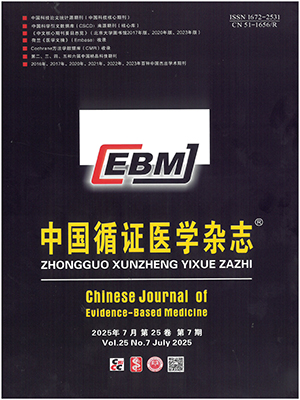| 1. |
World Health Organization. Public health emergencies.
|
| 2. |
中华人民共和国中央人民政府. 中华人民共和国国务院令第376号《突发公共卫生事件应急条例》. 2003.
|
| 3. |
|
| 4. |
|
| 5. |
|
| 6. |
|
| 7. |
|
| 8. |
|
| 9. |
|
| 10. |
|
| 11. |
|
| 12. |
Institute of Medicine (US) Committee to Advise the Public Health Service on Clinical Practice Guidelines. Clinical practice guidelines: directions for a new program. Washington (DC): National Academies Press (US), 1990.
|
| 13. |
|
| 14. |
World Health Organization. Severe acute respiratory syndrome (SARS).
|
| 15. |
World Health Organization. Influenza A (H1N1) outbreak.
|
| 16. |
World Health Organization. Coronavirus disease (COVID-19).
|
| 17. |
|
| 18. |
National Health Commission (NHC) of the PRC National Administration of Traditional Chinese Medicine of the PRC. Guidance for corona virus disease 2019 prevention: control, diagnosis and management. Beijing: People’s Medical Publishing House, 2020.National Health Commission (NHC) of the PRC National Administration of Traditional Chinese Medicine of the PRC. Guidance for corona virus disease 2019 prevention: control, diagnosis and management. Beijing: People’s Medical Publishing House, 2020.
|
| 19. |
广东省中医局办公室. 关于印发广东省新型冠状病毒感染的肺炎中医药治疗方案(试行第一版)的通知. 2020.
|
| 20. |
|
| 21. |
|
| 22. |
|
| 23. |
|
| 24. |
甘肃省卫生健康委员会. 关于印发甘肃省新型冠状病毒感染的肺炎中医药防治方案(试行)的通知. 2020.
|
| 25. |
湖南省中医药管理局. 关于印发《湖南省新冠肺炎患者恢复期中医药康复诊疗方案(试行)》的通知. 2020.
|
| 26. |
|
| 27. |
广西壮族自治区中医药管理局. 自治区中医药局关于印发新型冠状病毒肺炎中医药治疗方案(试行第三版)的通知. 2020.
|
| 28. |
河北省中医药管理局. 河北省中医药管理局关于印发河北省新型冠状病毒感染的肺炎 中医防治方案(试行第一版)的通知. 2020.
|
| 29. |
河南省卫生健康委员会. 河南省发布新型冠状病毒感染的肺炎中医药预防方案. 2020.
|
| 30. |
|
| 31. |
山西省卫生健康委员会. 关于印发《山西省新型冠状病毒感染的肺炎中医药防治方案(试行)》. 2020.
|
| 32. |
湖南省中医药管理局. 关于印发《湖南省新型冠状病毒感染的肺炎中医药诊疗方案(试行第三版)》的通知. 2020.
|
| 33. |
|
| 34. |
江西省卫生健康委员会. 江西发布新型冠状病毒感染的肺炎中医药防治方案(试行). 2020.
|
| 35. |
上海市新型冠状病毒感染的肺炎疫情防控工作领导小组办公室. 上海市新型冠状病毒感染的肺炎中医诊疗方案(试行). 2020.
|
| 36. |
山东省卫生健康委员会. 山东省2020年冬春流感、新冠肺炎中医药预防方案发布. 2020.
|
| 37. |
陕西省卫生健康委员会. 陕西省卫健委发布新型冠状病毒感染的肺炎中医药防治方案. 2020.
|
| 38. |
四川省中医药管理局. 四川省新型冠状病毒感染的肺炎中医药干预建议处方(试行第一版). 2020.
|
| 39. |
武汉市卫生健康委员会. 武汉市出台新型冠状病毒感染的肺炎中医药居家预防推荐方案. 2020.
|
| 40. |
天津市卫生健康委员会. 天津市新型冠状病毒感染的肺炎中医药防治方案(试行第二版). 2020.
|
| 41. |
西藏自治区藏医药管理局. 关于印发西藏自治区新型冠状病毒感染的肺炎藏医药防治方案的通知. 2020.
|
| 42. |
|
| 43. |
|
| 44. |
|
| 45. |
|
| 46. |
|
| 47. |
国家重点研发计划“中风后主要功能障碍的中医康复研究”项目组. 新型冠状病毒肺炎愈后患者中医家庭康复指导方案(试行). 2020.
|
| 48. |
|
| 49. |
云南省卫生健康委, 云南省中医药管理局. 云南省卫生健康委发布新型冠状病毒感染的肺炎中医药防治方案. 2020.
|
| 50. |
中国针灸学会. 关于印发《新型冠状病毒肺炎针灸干预的指导意见(第二版)》. 2020.
|
| 51. |
|
| 52. |
|
| 53. |
|
| 54. |
|
| 55. |
中国针灸学会. 关于印发《新型冠状病毒肺炎针灸干预的指导意见(第一版)》的通知. 2020.
|
| 56. |
|
| 57. |
国家卫生健康委办公厅, 国家中医药管理局办公室. 关于印发新型冠状病毒感染的肺炎诊疗方案(试行第三版)的通知. 2020.
|
| 58. |
国家卫生健康委办公厅, 国家中医药管理局办公室. 关于印发新型冠状病毒感染的肺炎诊疗方案(试行第四版)的通知. 2020.
|
| 59. |
国家卫生健康委办公厅, 国家中医药管理局办公室. 关于印发新型冠状病毒感染的肺炎诊疗方案(试行第五版)的通知. 2020.
|
| 60. |
国家卫生健康委办公厅, 国家中医药管理局办公室. 关于印发新型冠状病毒感染的肺炎诊疗方案(试行第六版)的通知. 2020.
|
| 61. |
国家卫生健康委办公厅, 国家中医药管理局办公室. 关于印发新型冠状病毒感染的肺炎诊疗方案(试行第七版)的通知. 2020.
|
| 62. |
|
| 63. |
卫生部办公厅. 卫生部办公厅关于印发《甲型H1N1流感诊疗方案(2009年试行版第一版)》的通知. 2009.
|
| 64. |
卫生部办公厅. 卫生部办公厅关于印发《甲型H1N1流感诊疗方案(2009 年试行版第二版)》的通知. 2009.
|
| 65. |
卫生部办公厅, 国家中医药管理局办公室. 卫生部办公厅、国家中医药管理局办公室关于印发《甲型H1N1流感中医药预防方案(2009版)》的通知. 2009.
|
| 66. |
|
| 67. |
|
| 68. |
|
| 69. |
|
| 70. |
|
| 71. |
|
| 72. |
|
| 73. |
|
| 74. |
|
| 75. |
|
| 76. |
|
| 77. |
|
| 78. |
|
| 79. |
|
| 80. |
|
| 81. |
|
| 82. |
国家医疗保障局 财政部关于做好新型冠状病毒感染的肺炎疫情医疗保障的通知. 2020.
|
| 83. |
国家医疗保障局办公室 财政部办公厅 国家卫生健康委办公厅关于做好新型冠状病毒感染的肺炎疫情医疗保障工作的补充通知. 2020.
|
| 84. |
|
| 85. |
|
| 86. |
|
| 87. |
|




